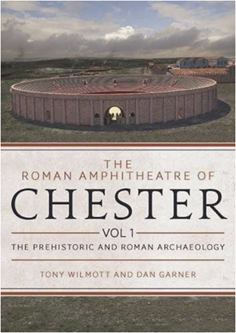
This first volume detailing the results of the 2004–2006 excavations within the Roman amphitheatre in Chester provides an opportunity to reflect on how approaches to studying major monuments have shifted over the last half century or so. Earlier work in the 1960s prioritised seeking knowledge about the Roman amphitheatre to the exclusion of all other periods. That goal resulted in deposits exceeding 3.5m deep, which overlie the Roman levels being machined away without record, an approach that the excavator later regretted for being “a little ruthless and ham-fisted” (p. 19). Readers of the present publication will also have to content themselves with only a few paragraphs detailing post-Roman activity on the site, but for very different reasons. It is not because the evidence was entirely eradicated in the 1960s, or because it is still judged of limited value; it is because an entire second volume will be dedicated to this topic. Adopting a holistic approach and using the most prominent structure to occupy the site as a vehicle to explore the entirety of human activity on it also results in an account that stretches as far back as the Mesolithic. The resulting excavation report is all the richer for it.
While Roman activity on the amphitheatre site receives the lion’s share of attention in this volume, the prehistoric layers sealed underneath more than reward the attention that they received. Key finds include a roundhouse and adjacent four-post structure, which returned radiocarbon dates of 400–200 cal BC, making this the earliest evidence for settled occupation in Chester. Archaeobotanical material from three of the four postholes suggests that the structure housed surprising contents. Rather than conventional crops, these stores took the form of by-products from cereal processing, specifically weed- and chaff-rich material. Both commodities offered a source of fodder, while the latter could temper daub or act as fuel. Even more important was the discovery of cord rig, a distinctive late prehistoric cultivation technique employing close-set ranks of narrow raised beds. This is believed to be the first identification of cord rig south of the concentration in Northumberland, where numerous examples of agricultural features have been found sealed beneath Roman military works associated with the northern frontier. The survival of upstanding cord rig at Chester suggests that there, too, actively worked arable land was appropriated by the army, dispossessing local farmers.
A key conclusion of the 1960s campaign was that the first amphitheatre at Chester was a turf and timber affair, with the masonry elements belonging to a later rebuild. The 2004–2006 work revealed that the monument boasted a stone outer wall from the start, adding it to a select group of structures associated with the fortress that originally featured masonry components. As with some of these, work on the earliest amphitheatre (1a) appears to have been aborted before it was finished. The apparent hiatus before completion of the amphitheatre (1b) has been linked to a change in the resident garrison. When this building was in turn replaced it was encased by the successor amphitheatre (2), which was constructed on a scale that makes it the largest example currently known from Roman Britain. Sadly, as the excavators note, “the level of survival […] is in inverse proportion to its original size and form” (p. 162). Nevertheless, ingenious study of the surviving structural elements allows a somewhat austere superstructure to be reconstructed with a high degree of certainty.
One of the most fascinating elements of the report is the evidence for activity in and around the 1a and 1b amphitheatres. Postholes beside an external stair to amphitheatre 1b would suit a tented stall similar to that featured on a Pompeian fresco, while the unusually high proportion of poultry bones may point to a popular spectator snack food. The long-known shrine dedicated to the goddess Nemesis provides evidence for ritual activity, alongside another small, near-square feature also interpreted as a shrine. One puzzling feature is the wealth of finds associated with activity at the—seemingly unfinished—amphitheatre 1a. Pit 1256, which is interpreted as one of three latrines servicing patrons during this period, is of particular interest here. It was apparently filled over a short period with layers containing material such as pottery, glass, small bronze objects—including a representation of a human face—a single coin of AD 85, animal and fish bones, and, in the uppermost layer, a sawn piece of deer antler. This is perfectly reasonably viewed as rubbish. Even so, Holly Miller and Naomi Sykes have recently discussed the use of deer antlers in Roman zootherapy, seemingly strengthening Christian Karst’s equally recent proposal that combinations of deer antler and objects including isolated coins in subterranean structured deposits at Roman military sites could have ritual significance. It is possible that the contents of pit 1256 were more deliberate than they appear.
It is clear throughout that the excavations were conducted with a precision and flair to be expected from a team managed by directors with the combined experience of Wilmott and Garner. They are also to be congratulated on a report that manages to combine engaging and incisive overviews of the amphitheatre and its environs—including the fortress—with a detailed scientific account of the work and its results. The stratigraphic sequence can be easily cross-referenced with the wide-ranging specialist reports, allowing interpretations to be interrogated. Such a pursuit is aided by the wealth of colour plans, and indeed images of all kinds. Among these, the reconstructions of the amphitheatre 1b seating framework and the entirety of amphitheatre 2 are especially impressive. The text displays a keen awareness of comparanda from amphitheatres elsewhere in the empire, making this volume an essential contribution to the study of these structures and provincial life in Roman Britain more generally. A teaser for the second volume provided in the conclusion to this instalment indicates that the amphitheatre proved to be of long-standing importance; the same will surely be true of this report.


